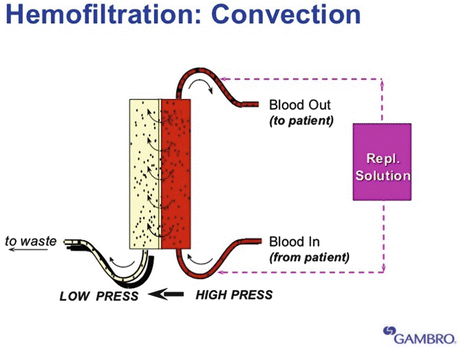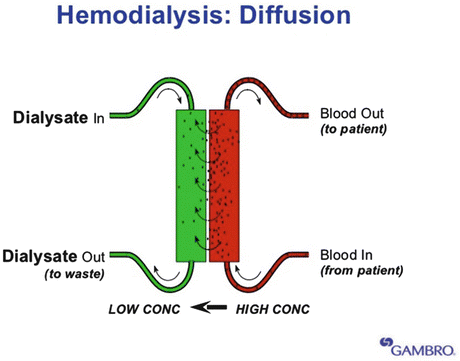and Fatemeh Ghane Sharbaf2
(1)
Department of Pediatrics Section of Nephrology, Rush University Medical Center, Chicago, IL, USA
(2)
Department of Pediatrics Section of Nephrology, Mashhad University of Medical Sciences, Mashhad, Iran
Basic Concept of Solute Transport Mechanism
Water and solutes are transported through three different mechanisms: convection, diffusion, and ultrafiltration. The molecular size of the solute dictates which transport mechanism is required (Table 2.1). Molecular weights are measured in units called daltons . Urea, electrolytes, buffers, creatinine, glucose, and uric acid are a few examples of the “small”-molecular-size solutes (<350 Da). Vitamin B12 is a “middle”-molecule-size solute (1355 Da). Bilirubin, beta-2 microglobulin, myoglobin, and pro-inflammatory mediators of sepsis such as TNF-alpha, complement, and interleukin are all large-molecular-size solutes (5000–60,000 Da) (Table 2.1). Generally, the more a molecule weighs, the larger it is in size and the more resistant it is to transport [1–5].
Table 2.1
Solute molecular weights
Small molecular weights (daltons) | Middle molecular weights (daltons) | Large molecular weights (daltons) |
|---|---|---|
Sodium (23) | Uric acid (168) | Inulin (5200) |
Potassium (35) | Glucose (180) | Beta-2 microglobulin (11,800) |
Urea (60) | Albumin/deferoxamine complex (700) | Inflammatory mediators (1200–40,000) |
Creatinine (113) | Vitamin B12 (1355) | Albumin (55,000–60,000) |
Each CRRT modality provides at least one transport mechanism to move fluid and/or solutes out of or into the bloodstream. While ultrafiltration is used to transport fluid, there are three transport mechanisms to transport solutes: diffusion, convection, and adsorption. Understanding the principles of ultrafiltration, diffusion, convection, and adsorption helps to clarify which therapy or combination of therapies will best produce the desired outcome [1–3, 6–10].
Convection Transport Mechanism
Convection is defined as the movement of molecules across a semipermeable membrane due to a pressure gradient. The water pulls the molecule along with it as it follows through the membrane (solvent drag). In convection, plasma water moves along pressure gradients and will remove middle and large molecules [6, 8]. The pressure gradient in the extracellular circuit is increased by a positive pressure gradient (hydrostatic pressure) or oncotic pressure generated by non-permeable solutes (Fig. 2.1). Replacement fluid increases the amount of convective solute removal in CRRT. The effluent pump forces plasma water and solutes across the membrane in the filter. The fluid removed is referred to as “ultrafiltration.” Ultrafiltrate is removed from the dialyzer and disposed of as effluent (Fig. 2.2). Increasing ultrafiltration rate will increase clearance by convection, and this requires more replacement solution. This transport mechanism is used in slow continuous ultrafiltration (SCUF), continuous veno-venous hemofiltration (CVVH), continuous veno-venous hemodialysis (CVVHD), and continuous veno-venous hemodiafiltration (CVVHDF) modalities [5, 11–13].



Fig. 2.1
Hemofiltration: convection transport mechanism (Gambro Training Manual, used with permission)

Fig. 2.2
Ultrafiltration: the movement of solutes from an area of higher pressure to an area of lower pressure (Gambro Training Manual, used with permission)
Diffusion Transport Mechanism
Diffusion is defined as the movement of solutes from an area of higher concentration to an area of lower concentration. In diffusion, the solvent moves by concentration gradient (Fig. 2.3). The solute gradually diffuses through the membrane from the area of high salt concentration to the area of low salt concentration (osmosis gradient) until it is evenly distributed. A uniform solution is created as seen in the cup on the left side of the membrane.


Fig. 2.3
Hemodialysis: diffusion transport (Gambro Training Manual, used with permission)
In the schematic, we can see how diffusion is created by dialysis therapy. Solutes travel from the area of high concentration on the blood side to the area of low concentration on the dialysate side (Fig. 2.3). The dialysate prescription is adjusted to preserve necessary solutes and remove unwanted solutes such as excess potassium or urea and creatinine. Note that dialysate flow is established countercurrent to the blood flow. This serves to increase effectiveness and maximize clearance [1, 2].
< div class='tao-gold-member'>
Only gold members can continue reading. Log In or Register to continue
Stay updated, free articles. Join our Telegram channel

Full access? Get Clinical Tree


